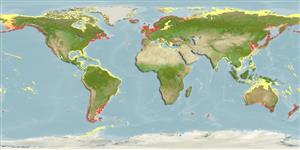Common names from other countries
Environment: milieu / climate zone / depth range / distribution range
Ecologie
; brakwater; diepteverspreiding 0 - 60 m (Ref. 7726). Temperate, preferred 9°C (Ref. 107945); 89°N - 58°S, 112°E - 61°E
Circumpolar.
Length at first maturity / Size / Gewicht / Leeftijd
Maturity: Lm ? range ? - ? cm Max length : 11.0 cm SHL mannelijk/geslacht niet bekend; (Ref. 95344); Maximaal vermelde leeftijd: 24 jaren (Ref. 8702)
Minimum depth (intertidal zone) from Ref. 95344. Inhabits intertidal areas (Ref. 2789). Found in quiet, sheltered areas forming dense aggregates on hard surfaces; attached by strong byssal threads (Ref. 95344). In the Vainameri, north-eastern Baltic Sea, most abundant in silty substrate (Ref. 95753). It is infaunal on sand and eelgrass beds and epifaunal on eelgrass beds (Ref. 95819). Also found on mixed sediments with gravel (Ref. 118257). Semi-mobile suspension feeder (Refs. 95752, 96470). Feeds on phytoplankton such as green algae, dinoflagellates and diatoms (Ref. 95805).
Life cycle and mating behavior
Geslachtsrijpheid | Voortplanting | Kuitschieten | Eieren | Fecundity | Larven
Members of the class Bivalvia are mostly gonochoric, some are protandric hermaphrodites. Life cycle: Embryos develop into free-swimming trocophore larvae, succeeded by the bivalve veliger, resembling a miniature clam.
Harvey-Clark, C. 1997. (Ref. 7726)
Status op de Rode Lijst van het IUCN (Ref. 130435)
Status bij CITES (Ref. 108899)
Not Evaluated
Not Evaluated
Gebruik door de mens
Visserij: commercieel
FAO - Aquacultuur: production, soortsprofiel; Visserij: landings, soortsprofiel | FishSource | Sea Around Us
Tools
Internet-bronnen
Estimates based on models
Preferred temperature
(Ref.
115969): 4.4 - 16.1, mean 10.2 (based on 1512 cells).
Weerstandsvermogen
Hoog, minimale populatieverdubbelingstijd minder dan 15 maanden (K=0.05-1.14; tmax=24).
Prior r = 0.54, 95% CL = 0.36 - 0.82, Based on 1 data-limited stock assessment.
Kwetsbaarheid
Moderate vulnerability (36 of 100).
